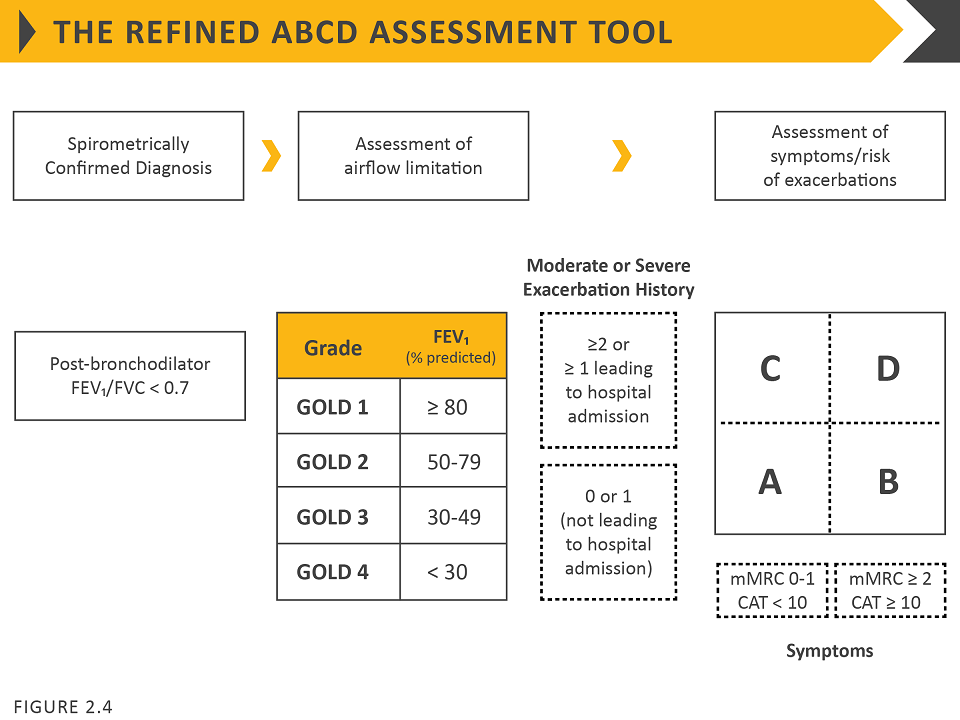assessment and monitoring of COPD
Last edited 02/2021 and last reviewed 07/2021
assessment and monitoring of disease
Assessment of a COPD patient should be carried out to guide management and should include the level of airflow limitation, impact on the patient 's health status and the risk of future events (such as exacerbation, hospital admissions or death) (1).
The Global Initiative for Chronic Obstructive Lung Disease (GOLD) recommends that COPD assessment should consider the following aspects of the disease separately:
- presence and severity of the spirometric abnormalities
- the severity of airflow limitation is classified according to post-bronchodilator FEV1
- in patients with FEV1/FVC <0.70
|
GOLD 1 |
mild |
FEV1>=80% of predicted |
|
GOLD 2 |
moderate |
50%<= FEV1<80% of predicted |
|
GOLD 3 |
severe |
30%<= FEV1<50% of predicted |
|
GOLD 4 |
very severe |
FEV1<30% of predicted |
- current nature and magnitude of the patients symptoms
- COPD was considered to be a condition largely characterised by dyspnoea, hence Modified British Medical Research Council (mMRC) questionnaire was used to assess the symptoms
- however, it is recommended that a more comprehensive assessment of symptoms should be used since symptoms other than dyspnoea also impacts patients life
- questionnaires such as Chronic Respiratory Questionnaire (CRQ) and St. George 's Respiratory Questionnaire (SGRQ) have been shown to be too complex to use in routine clinical practice
- more shorter questionnaires have been developed which can be used
in daily practice e.g. - COPD Assessment test (CAT), the COPD Control
Questionnaire (The CCQ)
Combined COPD assessment
The "ABCD" assessment tool has been developed by GOLD which incorporates patient 's symptomatic assessment with spirometric classification and/or risk of exacerbation.
- in the revised assessment scheme, patients should
- undergo spirometry to determine the severity of airflow limitation (e.g. - spirometric grade)
- undergo assessment of dyspnoea using mMRC or symptoms using CAT
- have their history of moderate or severe exacerbation (including prior hospitalisation) recorded
- this assessment tool recognise the limitation of FEV1 in making treatment decisions in individual patients and highlights the importance of patient symptoms and exacerbation risks in determining COPD treatment
- furthermore this will help more precise treatment recommendations based on parameters that are driving the patient 's symptoms at any given time (1)
Global Initiative for Chronic Obstructive Lung Disease (GOLD) criteria [1]
Classification of severity of airflow limitation in COPD: In pulmonary function testing, a post-bronchodilator FEV1/FVC ratio of <0.70 is commonly considered diagnostic for COPD.
The Global Initiative for Chronic Obstructive Lung Disease (GOLD) system categorises airflow limitation into stages. In patients with FEV1/FVC <0.70:
-
GOLD 1 - mild: FEV1<= 80% predicted
-
GOLD 2 - moderate: 50% = FEV1 < 80% predicted
-
GOLD 3 - severe: 30% = FEV1 < 50% predicted
-
GOLD 4 - very severe: FEV1 <30% predicted
The refined ABCD assessment tool (1)

The categories are therefore defined via consideration of two specific features:
- exacerbation history and
- symptom Score (either assessment of dyspnoea via mMRC OR assessment of symptoms via CAT)
Category A is defined by:
Moderate or Severe Exacerbation History Symptom Score 0 or 1 (not leading to hospital admission) mMRC 0 or 1 or CAT <10
Category B is defined by:
Moderate or Severe Exacerbation History Symptom Score 0 or 1 (not leading to hospital admission) mMRC >=2 or CAT >=10
Category C is defined by:
Moderate or Severe Exacerbation History Symptom Score >=2 or 1 leading to hospital admission mMRC 0 or 1 or CAT <10
Category D is defined by:
Moderate or Severe Exacerbation History Symptom Score >=2 or 1 leading to hospital admission mMRC >=2 or CAT >=10
The combined COPD assessment allows patients with the same FEV1 (defined by the GOLD criteria) to be differentiated based on symptomatology, for example
- a subject with an FEV1 <30% with an mMRC of 2 and three exacerbations in the past year would be labelled GOLD grade 4, group D;
- wheres a subject with an FEV1 < 30% with an mMRC of 1 and zero exacerbations in the past year would be labelled GOLD grade 4, group A
COPD assessment test
COPD assessment test (CAT) is an 8 item uni-dimensional measure of health status impairment in COPD.
- patients may score between 0-40
- measures the symptomatic impact of COPD but do not categorize patients into symptom severity groups for the purpose of treatment
CAT questionnaire can be found at http://www.catestonline.org/
St. George 's Respiratory Questionnaire (SGRQ) is the most widely documented comprehensive measure which uses a score of >=25 as the cut off point for considering regular treatment for symptoms. The equivalent cut off point for CAT is 10
Reference: